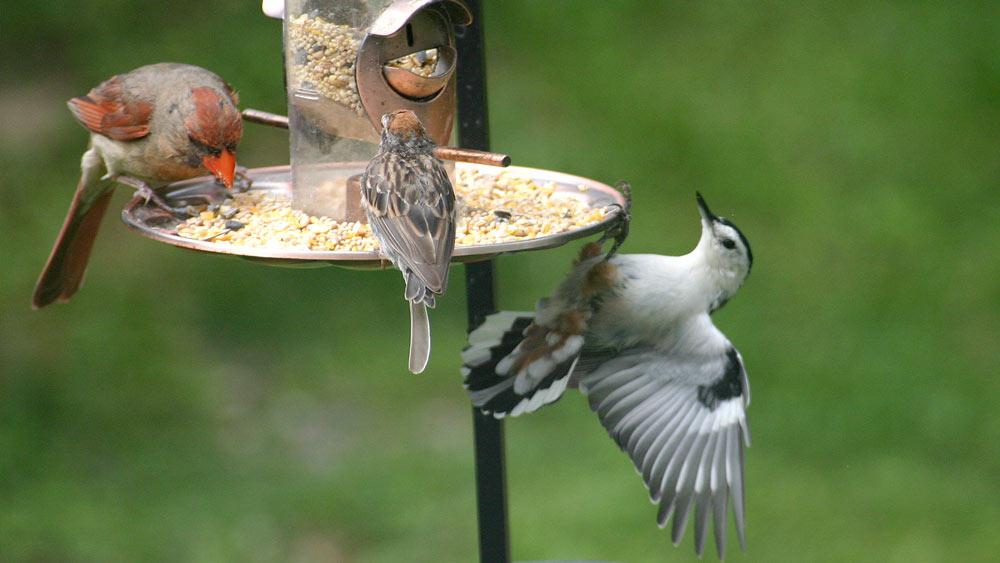When I first came to Talbot County I stayed at my brother-in-law and sister’s place for several months. One side of the house is edged in woodland and the other side features large, expansive meadows. In other words, a birder’s paradise.
While I was there, I placed four seed bird feeders, three bluebird houses two flat feeders for mealworms, and two hummingbird feeders.
I was well rewarded! (And, yes, I acknowledge that we are not supposed to feed them in the summer…so before I migrate in the winter, I purchase a large guilt bag of sunflower seeds and spread it all over my outdoor furniture and the grass.)
All three of the bluebird houses had nests. Bluebirds were everywhere, a male was usually perched on the fence, guarding his brood.
I had so many goldfinches that I had to fill two large bird feeders twice a day. Interspersed with the goldfinches were other colorful birds and their bland female mates: cardinals, house finches, indigo buntings, and blue jays. I even had several migratory Rose Crested Grosbeaks and a Blue Grosbeak. My fruit and nut feeder became a popular restaurant for woodpeckers: red bellied woodpeckers, hairy woodpeckers, northern flickers and downy woodpeckers.
The hummingbird feeders were awash with hummingbirds, who, it turns out are a little nasty. After watching some bullying behaviors, I put up more hummingbird feeders so that there would be enough for all; but they preferred to fight.
Convinced that I had found my birder’s paradise, I kept my bird books and my binoculars handy and when I moved into a new residence in town, I put up three bird feeders and a mealworm feeder. Then I patiently waited for these beautiful birds to find my feeders.
And I waited.
And waited.
And waited.
Finally, a swarm of blackbirds descended on the feeders and devoured all of the sunflower seed. Soon brown birds found the feeders as well.
I did more research. I had been careful not to use cracked corn, I tried other combinations. I tried safflower seeds (I couldn’t find a single bird that would eat them, even the brown and black ones). I tried other mixes. The blackbirds just spit out what they didn’t like onto the ground. The ground beneath the feeders became a green carpet of millet seedlings.
The blackbirds also enjoy the mealworms; no bluebirds or Carolina wrens for me.
After devouring my sunflower seeds, the black and brown birds pelt my patio and furniture with excrement.
Between black and brown bird meals, my bird feeders serve as a training center for the rodent Olympics. Gray squirrels train for aerial leap, uneven feeders, and wire gnawing events. Despite frequent repairs, they have successfully destroyed two bird feeders this year.
As for hummingbirds, I tried different commercial foods. I even made my own hummingbird nectar. I planted an orange honeysuckle bush. But it turns out that most of my neighbors also have hummingbird feeders; and the hummingbirds preferred their feeders to mine.
It is now late summer, and the blackbirds have departed for the fields, leaving it all for the brown birds and squirrels. The aggressive little sparrows seem to have a way of keeping keep other birds away.
Occasionally I see a house finch, a chickadee, a cardinal, a tufted titmouse (horrible name) or a blue jay. But that is pretty much it, just a bunch of brown or black birds.
As I am writing this, I spy a doughty female cardinal fledgling on one of my feeders.
I’ll take it.
Angela Rieck, a Caroline County native, received her PhD in Mathematical Psychology from the University of Maryland and worked as a scientist at Bell Labs, and other high-tech companies in New Jersey before retiring as a corporate executive. Angela and her dogs divide their time between St Michaels and Key West Florida. Her daughter lives and works in New York City.



Gretchen F Stroh says
This is the first year I have been keeping up with my birdfeeder, in Rock Hall, off a small creek. I’ve really enjoyed it. I’ve had bluejays, cardinals and their families, finches, nuthatches, chicadees, various brown and black birds, doves, squirrels, and a duck!